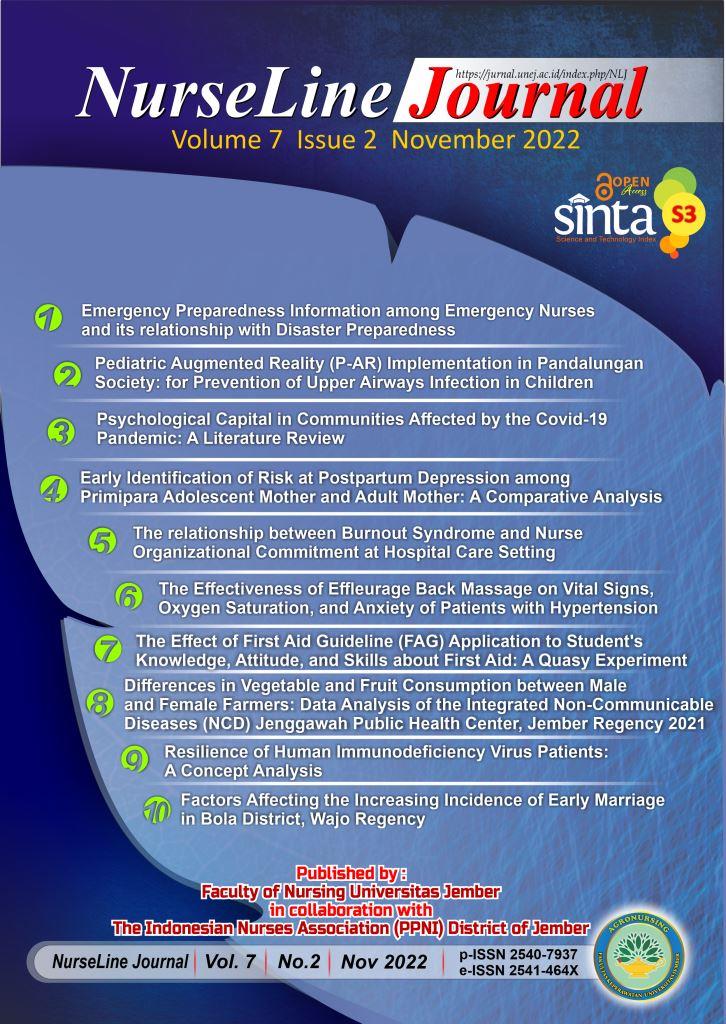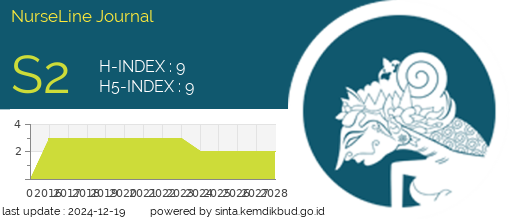The Effect Of First Aid Guideline (F.A.G) Application To Student’s Knowledge, Attitude, and Skills about First Aid Using Health Belief Model
DOI:
https://doi.org/10.19184/nlj.v7i2.31777Keywords:
first aid education, mobile application, traditionalAbstract
First aid given by laypersons in trauma cases has more mistakes. Injuries that occur require appropriate treatments. First aid education is part of health promotion. First aid guideline application (FAG) is a new education method. This study aimed to analyze the difference in students' knowledge, attitude and skill improvement in first aid by using FAG application. The study design used quasy experiments using control and experimental group. Research location was in SMP Negeri 2 Jember. There were 120 respondents taken by purposive sampling technique with two groups. Data analysis used independent t-test. Statistic analysis using independent t-test. Variables of knowledge obtained the p-value = 0.008, meaning there is a significant increase of knowledge after getting first aid education by using the application of FAG. The attitude variable got a p-value = 0,023, meaning that there is significant attitude improvement after getting first aid education by using the application of FAG. Skill variable found that p-value = 0,035 meaning that there is significant skill improvement after getting first aid education by applying FAG. There are differences in variables of knowledge, attitudes and skills among Junior High School students between the intervention and control groups.
Downloads
References
Badan Penelitian dan Pengembangan Kesehatan. Riset Kesehatan Dasar (RISKESDAS) 2013. Lap Nas 2013. 2013;1–384.
Tannvik TD, Bakke HK, Wisborg T. A systematic literature review on first aid provided by laypeople to trauma victims. Acta Anaesthesiol Scand. 2012;56(10):1222–7.
Charlier N, Fraine B De. Games Based Learning as a Vehicle to Teach new Content : A Case Study. Case Study 2009;(c).
Buck E De, Remoortel H Van, Dieltjens T, Verstraeten H, Clarysse M, Moens O, et al. Evidence-based educational pathway for the integration of first aid training in school curricula. Resuscitation. 2015;94:8–22.
Jones, Bartlett. Health Belief Model. Jones and Bartlett Publisher. 2003;
Rahmayani I. Indonesia Raksasa Teknologi Digital ASIA. Kementeri Komun dan Informasi. 2017;
Sadeghi R, Sedhagat M, Ahmadi F. Comparison of the effect of an blended lecture teaching methods on students’ learning and satisfaction. J Adv Med Educ Prof. 2014;2(4):146–50.
Yunanto RA, Wihastuti TA, Rachmawati SD. Pengaruh Pelatihan Resusitasi Jantung Paru (RJP) Dengan Mobile Application Dan Simulasi Terhadap Pengetahuan, Keterampilan Dan Kesediaan Menjadi Bystander RJP Pada Siswa Smk Negeri 02 Singosari. 2017;
Jenson C, Forsyth D. Virtual reality simulation: using three dimentional technology to teach nursing students. Comput Informastics, Nurs. 2012;6(30):312–8.
Dela Pena-Bandalaria M. Impact of ICTs on open and distance learning in a developing country setting: The Philippine experience. Int Rev Res Open Distance Learn. 2007;1(8).
Suwaryo PA., Kristianto H. Video Media Pembelajaran Perawatan Luka Ulkus Diabetes Mellitus. Jurnal Ilmiah Keperawatan Kesehatan. 2015;11(1):31–9.
Delazer M et al. Learning complex arithmetic - an fMRI study. Cogn Brain Res. 2003;18:76–88.
Sharples M, Taylor J, Vavoula G. Towards a theory of mobile learning. Pap Present 4th World Conf mLearning, Cape Town, South Africa. 2005;
Gandhi, S. D, Mythili &, A T. Nursing students perceptions about traditional and innovative teaching strategies – a pilot study. J Krishna Inst Med Sci Univ. 2015;1(4):123–9.
Selvabaskar, Sivagami and Aishwarya. Consumer perception and attitude towards the usage of m-Health applications. Res J Pharm Technol. 2017;10(8):2567–72.
Lynch-Sauer J, VandenBosch TM, Kron F, Gjerde CL, Arato N, Sen A, et al. Nursing Students’ Attitudes Toward Video Games and Related New Media Technologies. J Nurs Educ. 2011;50(9):513–23. Available from: http://www.slackinc.com/doi/resolver.asp?doi=10.3928/01484834-20110531-04
Stroobants J, Monsieurs KG, Devriendt B, Dreezen C, Vets P, Mols P. Schoolchildren as BLS instructors for relatives and friends: Impact on attitude towards bystander CPR. Resuscitation. 2014;85(12):1769–74. Available from: http://dx.doi.org/10.1016/j.resuscitation.2014.10.013
Small, G. W. & Vorgan G. iBrain - Surviving the Technological Alterations of the Modern Mind. 2009;









